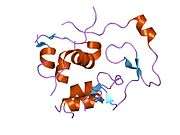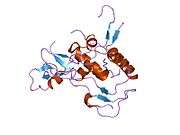IGFBP4
| View/Edit Human | View/Edit Mouse |
Insulin-like growth factor-binding protein 4 is a protein that in humans is encoded by the IGFBP4 gene.[3][4][5]
Function
This gene is a member of the insulin-like growth factor binding protein (IGFBP) family and encodes a protein with an IGFBP domain and a thyroglobulin type-I domain. The protein binds both insulin-like growth factors (IGFs) I and II and circulates in the plasma in both glycosylated and non-glycosylated forms. Binding of this protein prolongs the half-life of the IGFs and alters their interaction with cell surface receptors.[6] IGFBP-4 is a unique protein and it consistently inhibits several cancer cells in vivo and in vitro. Its inhibitory action has been shown in vivo in prostate and colon. It is secreted by all colon cancer cells.
Clinical significance
The protein itself does not prevent the formation of cancer.[7] However it may reduce the growth of cancer and act as an apoptotic factor.
Interactions
IGFBP4 has been shown to interact with Insulin-like growth factor 1 and 2.[8][9]
References
- ↑ "Human PubMed Reference:".
- ↑ "Mouse PubMed Reference:".
- ↑ LaTour D, Mohan S, Linkhart TA, Baylink DJ, Strong DD (May 1991). "Inhibitory insulin-like growth factor-binding protein: cloning, complete sequence, and physiological regulation". Mol Endocrinol. 4 (12): 1806–14. doi:10.1210/mend-4-12-1806. PMID 1707125.
- ↑ Shimasaki S, Uchiyama F, Shimonaka M, Ling N (Mar 1991). "Molecular cloning of the cDNAs encoding a novel insulin-like growth factor-binding protein from rat and human". Mol Endocrinol. 4 (10): 1451–8. doi:10.1210/mend-4-10-1451. PMID 1704481.
- ↑ Zazzi H, Nikoshkov A, Hall K, Luthman H (1998). "Structure and transcription regulation of the human insulin-like growth factor binding protein 4 gene (IGFBP4).". Genomics. 49 (3): 401–10. doi:10.1006/geno.1998.5283. PMID 9615225.
- ↑ "Entrez Gene: IGFBP4 insulin-like growth factor binding protein 4".
- ↑ Durai R, Yang SY, Seifalian AM, Goldspink G, Winslet MC (2007). "Role of insulin-like growth factor binding protein-4 in prevention of colon cancer". World J Surg Oncol. 5: 128. doi:10.1186/1477-7819-5-128. PMC 2203999
 . PMID 17988381.
. PMID 17988381. - ↑ Bach LA, Hsieh S, Sakano K, Fujiwara H, Perdue JF, Rechler MM (May 1993). "Binding of mutants of human insulin-like growth factor II to insulin-like growth factor binding proteins 1-6". J. Biol. Chem. 268 (13): 9246–54. PMID 7683646.
- ↑ Qin X, Strong DD, Baylink DJ, Mohan S (Sep 1998). "Structure-function analysis of the human insulin-like growth factor binding protein-4". J. Biol. Chem. 273 (36): 23509–16. doi:10.1074/jbc.273.36.23509. PMID 9722589.
Further reading
- Rajaram S, Baylink DJ, Mohan S (1998). "Insulin-like growth factor-binding proteins in serum and other biological fluids: regulation and functions.". Endocr. Rev. 18 (6): 801–31. doi:10.1210/er.18.6.801. PMID 9408744.
- Zhou R, Diehl D, Hoeflich A, Lahm H, Wolf E (2003). "IGF-binding protein-4: biochemical characteristics and functional consequences.". J. Endocrinol. 178 (2): 177–93. doi:10.1677/joe.0.1780177. PMID 12904166.
- Durai R, Davies M, Yang W, Yang SY, Seifalian A, Goldspink G, Winslet M (2006). "Biology of insulin-like growth factor binding protein-4 and its role in cancer (review).". Int. J. Oncol. 28 (6): 1317–25. doi:10.3892/ijo.28.6.1317. PMID 16685432.
- Giudice LC, Dsupin BA, Irwin JC, Eckert RL (1992). "Identification of insulin-like growth factor binding proteins in human oviduct.". Fertil. Steril. 57 (2): 294–301. PMID 1370941.
- Bajalica S, Allander SV, Ehrenborg E, Brøndum-Nielsen K, Luthman H, Larsson C (1992). "Localization of the human insulin-like growth-factor-binding protein 4 gene to chromosomal region 17q12-21.1.". Hum. Genet. 89 (2): 234–6. doi:10.1007/BF00217129. PMID 1375185.
- Kiefer MC, Schmid C, Waldvogel M, Schläpfer I, Futo E, Masiarz FR, Green K, Barr PJ, Zapf J (1992). "Characterization of recombinant human insulin-like growth factor binding proteins 4, 5, and 6 produced in yeast.". J. Biol. Chem. 267 (18): 12692–9. PMID 1377672.
- Zhou J, Bondy C (1992). "Insulin-like growth factor-II and its binding proteins in placental development.". Endocrinology. 131 (3): 1230–40. doi:10.1210/en.131.3.1230. PMID 1380437.
- Kiefer MC, Masiarz FR, Bauer DM, Zapf J (1991). "Identification and molecular cloning of two new 30-kDa insulin-like growth factor binding proteins isolated from adult human serum.". J. Biol. Chem. 266 (14): 9043–9. PMID 1709161.
- Culouscou JM, Shoyab M (1991). "Purification of a colon cancer cell growth inhibitor and its identification as an insulin-like growth factor binding protein.". Cancer Res. 51 (11): 2813–9. PMID 1709585.
- Tonin P, Ehrenborg E, Lenoir G, Feunteun J, Lynch H, Morgan K, Zazzi H, Vivier A, Pollak M, Huynh H (1994). "The human insulin-like growth factor-binding protein 4 gene maps to chromosome region 17q12-q21.1 and is close to the gene for hereditary breast-ovarian cancer.". Genomics. 18 (2): 414–7. doi:10.1006/geno.1993.1487. PMID 7507078.
- Ilvesmäki V, Blum WF, Voutilainen R (1994). "Insulin-like growth factor binding proteins in the human adrenal gland.". Mol. Cell. Endocrinol. 97 (1–2): 71–9. doi:10.1016/0303-7207(93)90212-3. PMID 7511544.
- Zhou J, Bondy C (1993). "Anatomy of the human ovarian insulin-like growth factor system". Biol. Reprod. 48 (3): 467–82. doi:10.1095/biolreprod48.3.467. PMID 7680905.
- Conover CA, Clarkson JT, Bale LK (1993). "Phorbol ester tumor promoters regulate insulin-like growth factor-binding protein-4 proteolysis". Endocrinology. 133 (3): 1347–51. doi:10.1210/en.133.3.1347. PMID 7689953.
- Fridell RA, Harding LS, Bogerd HP, Cullen BR (1995). "Identification of a novel human zinc finger protein that specifically interacts with the activation domain of lentiviral Tat proteins". Virology. 209 (2): 347–57. doi:10.1006/viro.1995.1266. PMID 7778269.
- Batch JA, Mercuri FA, Werther GA (1996). "Identification and localization of insulin-like growth factor-binding protein (IGFBP) messenger RNAs in human hair follicle dermal papilla". J. Invest. Dermatol. 106 (3): 471–5. doi:10.1111/1523-1747.ep12343649. PMID 8648179.
- Bonaldo MF, Lennon G, Soares MB (1997). "Normalization and subtraction: two approaches to facilitate gene discovery". Genome Res. 6 (9): 791–806. doi:10.1101/gr.6.9.791. PMID 8889548.
- Han VK, Matsell DG, Delhanty PJ, Hill DJ, Shimasaki S, Nygard K (1996). "IGF-binding protein mRNAs in the human fetus: tissue and cellular distribution of developmental expression". Horm. Res. 45 (3–5): 160–6. doi:10.1159/000184780. PMID 8964576.
- Di Battista JA, Doré S, Morin N, He Y, Pelletier JP, Martel-Pelletier J (1997). "Prostaglandin E2 stimulates insulin-like growth factor binding protein-4 expression and synthesis in cultured human articular chondrocytes: possible mediation by Ca(++)-calmodulin regulated processes". J. Cell. Biochem. 65 (3): 408–19. doi:10.1002/(SICI)1097-4644(19970601)65:3<408::AID-JCB10>3.0.CO;2-B. PMID 9138096.





